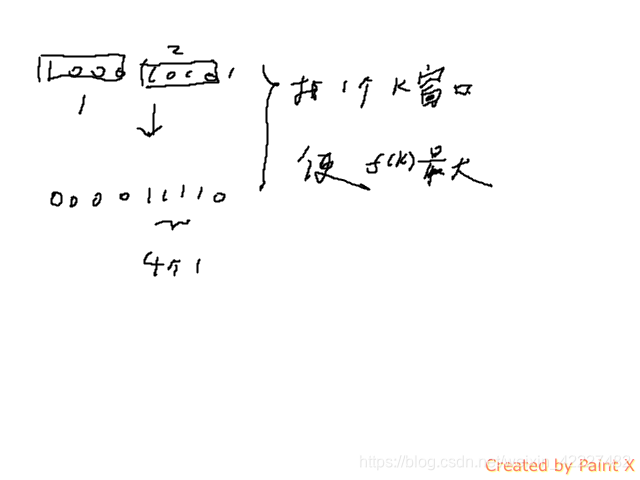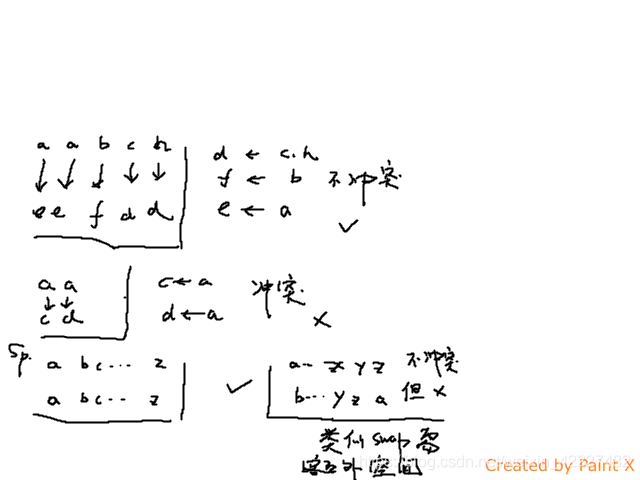p1: 略
p2: 考虑最终状态一定是所有1连在一起,所以只需要找这样的区间,使得区间内1的个数最多。

P3: 没什么技巧,按题意直接写。 竞赛时,我看题没仔细,忽略了非连续,忽略每个用户只算一次。所以WA了几次。
P4: 从str1映射到str2,必须是单射,再考虑str2可能包含全字符,这种情况必须是自映射才行。

object B6 {
object P4 {
def canConvert(str1: String, str2: String): Boolean = {
val table = scala.collection.mutable.HashMap[Char, Set[Char]]()
(str1 zip str2) foreach {case (x, y) => table.put(y,table.getOrElse(y, Set.empty[Char]) + x)}
for{
x <- 'a' to 'z'
y <- 'a' to 'z'
if x != y
if table.contains(x)
if table.contains(y)
if (table(x) & table(y)).nonEmpty
} return false
if(table.keySet.size == 26) table.keySet.forall(key => table(key).size == 1 && table(key).head == key)
else true
}
}
object P3 {
case class Pattern(l:List[String]){
def min(that:Pattern):Pattern = {
l zip that.l dropWhile {case (a, b) => a == b} match {
case Nil => this
case (a,b)::t => if(a < b) this else that
}
}
}
def mostVisitedPattern(u: Array[String], time: Array[Int], site: Array[String]): List[String] = {
val fre = scala.collection.mutable.HashMap[Pattern, Int]()
def f(l:List[String]):Unit = {
val seq = l.toArray
var xs = List.empty[Pattern]
for{
i <- 0 until seq.length
j <- i+1 until seq.length
k <- j+1 until seq.length
pattern = Pattern(seq(i)::seq(j)::seq(k)::Nil)
} if(!xs.contains(pattern)){
fre.put(pattern, 1 + fre.getOrElse(pattern, 0))
xs ::= pattern
}
}
val n = u.length
val log = (0 until n).toArray.map{i => (u(i), time(i), site(i))}
log
.groupBy{case (x,y,z) => x}.values.toList
.map{x => x.sortBy{case (x,y,z) => y}}
.map{x => x.map{case (x,y,z) => z}.toList} foreach f
def findMaxPattern(l:List[Pattern], n:Int = 0, p:Pattern = Pattern(Nil)):Pattern = l match {
case Nil => p
case h::t =>
if(fre(h) > n) findMaxPattern(t, fre(h), h)
else if(fre(h) == n) findMaxPattern(t, fre(h), h min p)
else findMaxPattern(t, n, p)
}
findMaxPattern(fre.keySet.toList).l
}
}
object P2 {
def cum(A:Array[Int]):Array[Int] = {
val B = Array.fill(A.length)(0)
for{i <- B.indices} if(i == 0) B(i) = A(i) else B(i) = B(i-1) + A(i)
B
}
def minSwaps(A: Array[Int]): Int = {
val n = A.length
val m = A.sum
if(m == 0) return 0
val B = cum(A)
def f(i:Int, acc:Int):Int = {
if(i + m >= n) acc
else f(i+1, acc max (B(i+m) - B(i)))
}
m - f(0,B(m-1))
}
}
object P1 {
def isMajorityElement(A: Array[Int], x: Int): Boolean = {
A.count(_==x) > (A.length / 2)
}
}
}








 本文深入探讨了算法竞赛中各类问题的解决策略,包括字符串映射、模式匹配、区间选择及多数元素判断等核心算法,提供了具体实现代码,帮助读者理解并掌握竞赛中常见算法题目的解题思路。
本文深入探讨了算法竞赛中各类问题的解决策略,包括字符串映射、模式匹配、区间选择及多数元素判断等核心算法,提供了具体实现代码,帮助读者理解并掌握竞赛中常见算法题目的解题思路。

















 被折叠的 条评论
为什么被折叠?
被折叠的 条评论
为什么被折叠?








